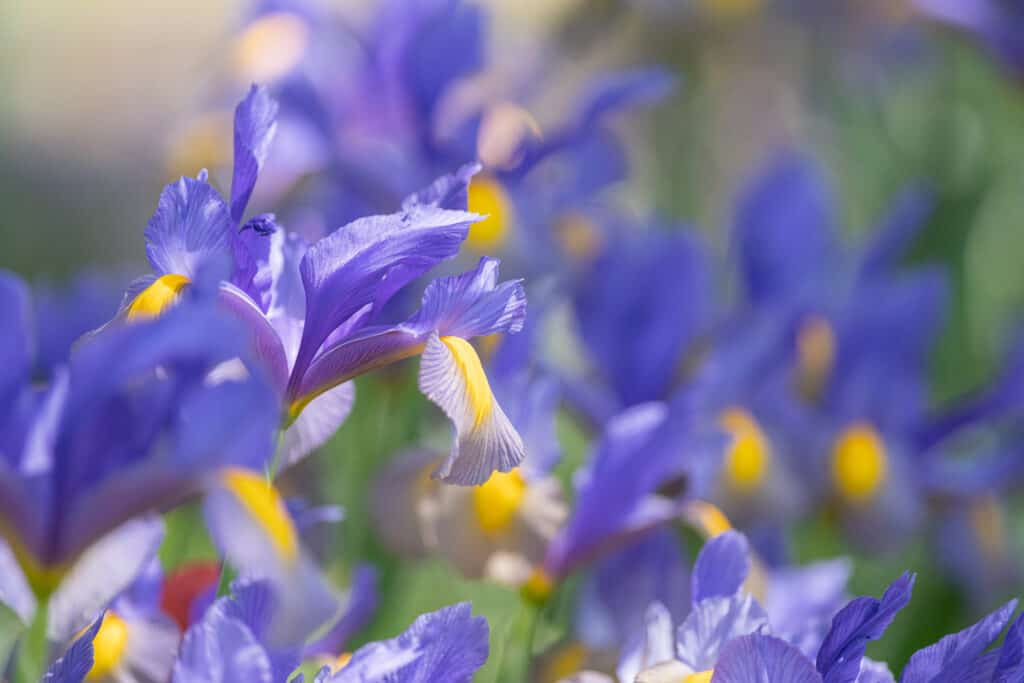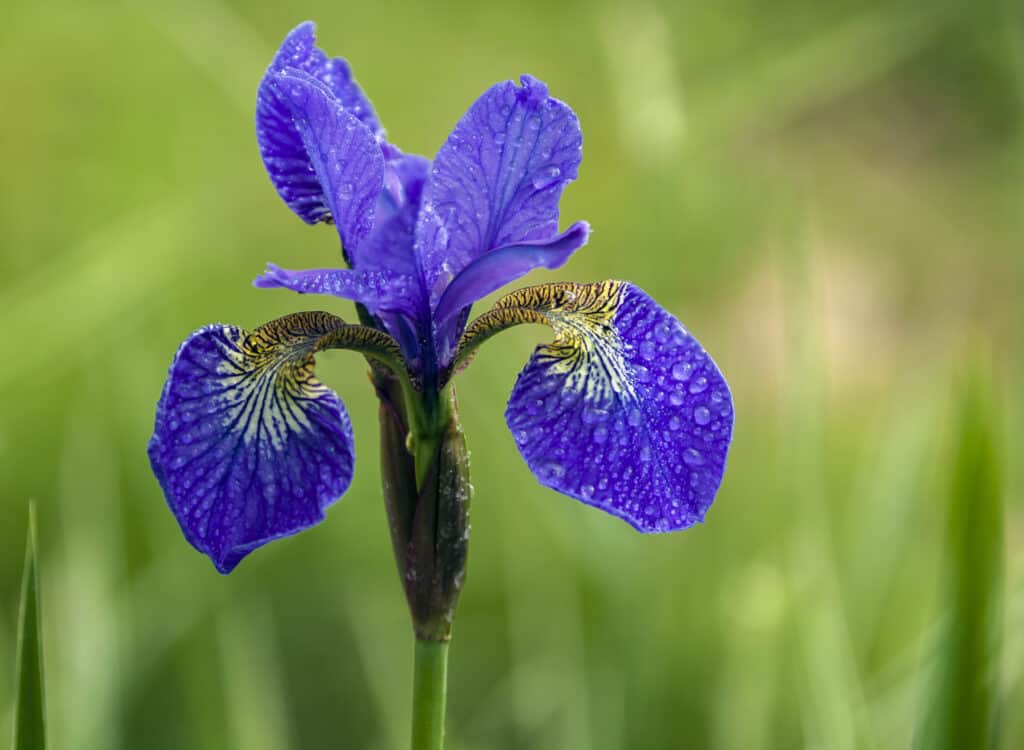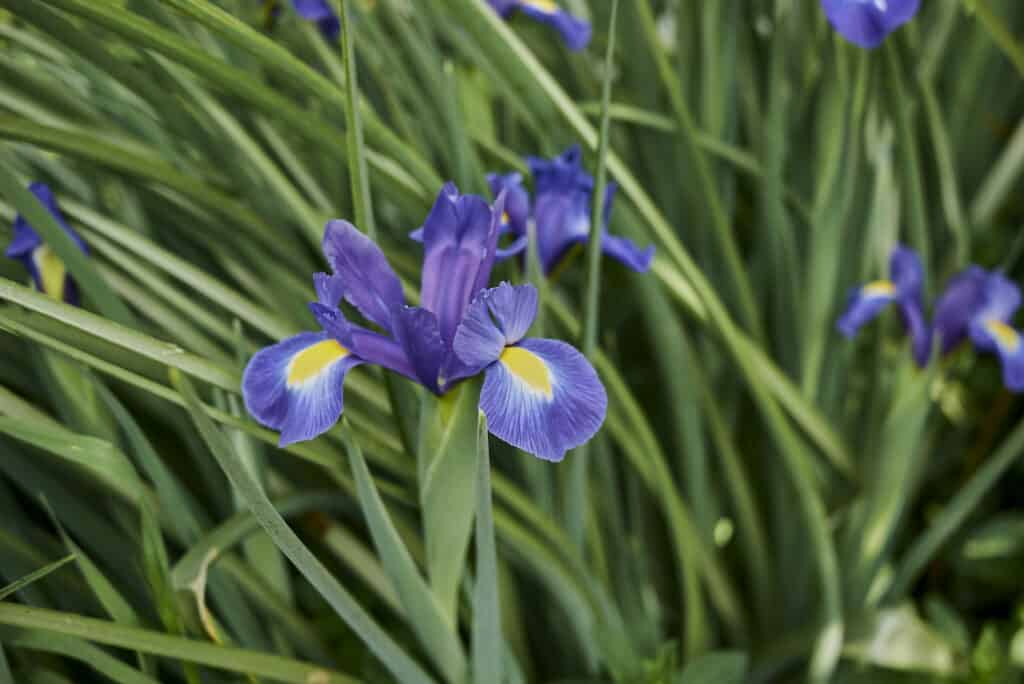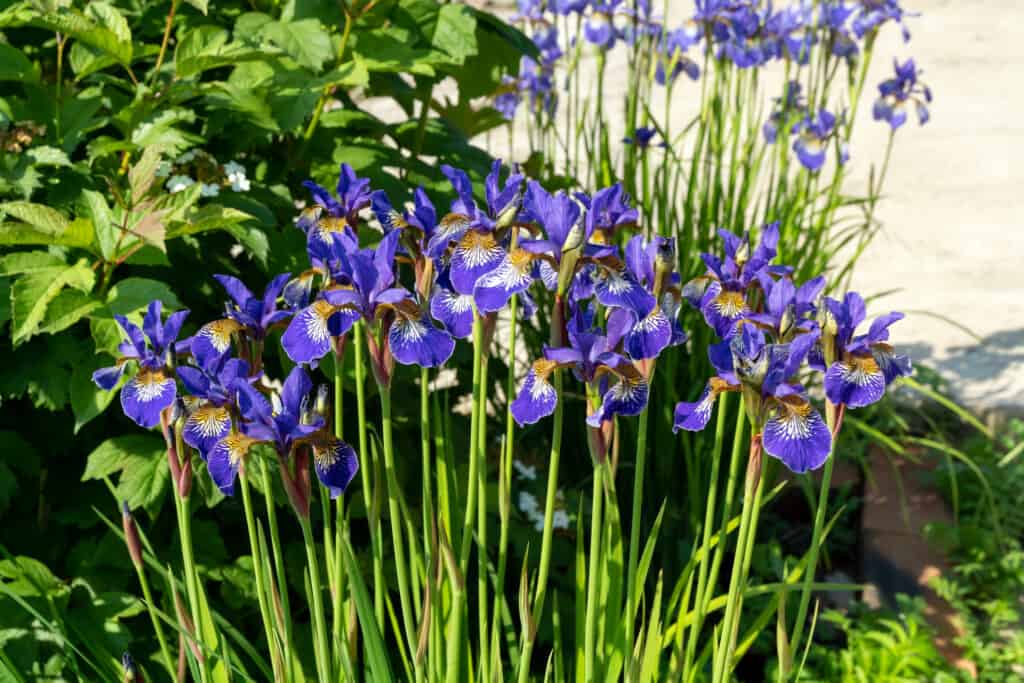The beauty of Iris flowers has captivated gardeners for a long time, resulting in over 300 cultivars of these amazing flowers! Because there are now so many different Iris flowers, there’s a huge range of what these flowers look like.
Iris flowers are often categorized into “bearded” and “non-bearded” types but, still, within these groups there are many different kinds. “iris” means rainbow in Greek and is a fitting name considering there’s an Iris flower in every color of the rainbow.
Thanks to breeders all around the world, there are the Dutch iris, Siberian iris, Japanese iris, dwarf iris, bearded iris, and many more. So, how do you tell one kind from the other with so many possibilities?
There are several differences between Dutch and Siberian irises that can help you identify the type and determine which one is best for your garden.
Dutch Iris vs. Siberian Iris at a Glance
| Dutch Iris | Siberian Iris | |
|---|---|---|
| Botanical Name | Iris hollandica | Iris sibirica |
| Flower Colors | Blue, Yellow, and White | Ranges from deep blue to violet, lavender, purple-red, or orange |
| Height | 1 to 2 feet tall | 2 to 4 feet tall |
| USDA Growing Zones | 6 to 9 | 3 to 8 |
| Soil Type | Sand, loam; well-draining | Consistently moist but well-draining |
| Water Needs | Average, frequent watering | More drought tolerant |
About Dutch Irises
The Dutch iris was cultivated as a hybrid of an iris from Spain and another from Morocco, so it’s not at all native to the Netherlands but it was created there. Since the original Iris hollandica, there have been many new hybrids developed, so the Dutch iris is considered a group of irises rather than one specific flower.
Dutch irises are some of the few iris flowers that grow from bulbs, while most of the other types grow from rhizomes. Dutch iris and dwarf iris are the only types that grow from bulbs, which helps in identifying the type of irises.
As with all iris flowers, Dutch irises are deer and rabbit resistant. They cause digestive problems- which help keep wild animals out of your garden- but also means you should keep your pets or kids away.

Dutch irises are some of the few iris flowers that grow from bulbs.
©iStock.com/rai
About Siberian Irises
The original Siberian iris is Iris sibirica but that flower has been used to breed many cultivars, many more than the Dutch iris, often creating a hybrid between the Siberian iris and another native Asian iris.
Because there are so many cultivars of Siberian iris, there’s a larger range of where these flowers can be grown. In general, these flowers are resilient and can tolerate both cold winters and hot temperatures.
As with most iris species, Siberian irises have rhizomatic roots and also make for great companion plants in gardens.

Siberian iris flowers are fluffier than the Dutch iris and open in all directions.
©iStock.com/Svetlana Popova
Dutch Iris vs. Siberian Iris: Appearance
Dutch irises are certainly different from dwarf irises, but they are more closely related. Dutch irises are also smaller than most iris flowers. They grow to about one or two feet tall and have a three-inch spread.
The stalk from which the flower blooms is very sturdy and will hold up while the flowers are in bloom. Similarly, the grayish-green foliage that surrounds the plant lasts during the spring but dies in mid-summer when the blooms are finished.
Siberian irises are quite taller- usually two to four feet tall and one to two feet wide. However, there are dwarf varieties of Siberian irises.
Also in contrast to Dutch irises, the foliage on Siberian irises stays green and sticks upright all summer long. Gardeners love these beautiful flowers in the spring, then can enjoy bright green, grass-like foliage during the summer!

Dutch irises are smaller than most iris flowers growing to approximately one or two feet tall with a three-inch spread.
©iStock.com/seven75
Dutch Iris vs. Siberian Iris: Flowers
Dutch and Siberian irises, along with all types of iris, are perennial plants, so they will flower year after year! They both bloom in late spring to early summer, although Dutch irises tend to bloom later, usually in June. The blooms last for two to three weeks.
Dutch iris flowers are about four inches across and bloom with three main petals, forming an open triangle shape. The petals on the original Dutch iris are indigo, bright yellow, and white, and all of the variations have some combination of these colors.
The original Siberian iris is deep purple and violet with a lavender center, but there’s an incredible variety of colors with Siberian irises. Some have deep blue and indigo petals, others are maroon, and red and some are even orange.
The shape of these flowers is quite different from Dutch irises if you look at the two side by side. Siberian iris flowers are fluffier and open in all directions, so the petals aren’t as easily distinguishable.

Siberian iris flowers range in color from deep blue to violet, lavender, purple-red, or orange.
©iStock.com/Svetlana Popova
Dutch Iris vs. Siberian Iris: Growing Zones
Dutch irises can grow in Zones 6-9, which include most of the southern half of the U.S.
Siberian irises have a higher tolerance for extreme temperatures and temperature fluctuations, so they can grow between Zones 3 and 8. This covers almost all of the U.S. except for the southern states.
Siberian irises can handle pretty high temperatures but if it’s too hot in the summer the plant will go dormant and its foliage will turn brown. They’re also generally very cold hardy, but they’ll do best in cold climates with moist soil.
Dutch Iris vs. Siberian Iris: Growing Needs
All iris flowers are generally low maintenance and don’t need any special care to grow well and produce beautiful flowers. Siberian irises specifically are known to be really easy-going because they’re so adaptable to almost any growing conditions.
The main maintenance that Siberian irises need is to have their roots trimmed yearly. Siberian irises, like most irises, have rhizomatic roots that will grow like crazy and all over the soil if they’re not clipped. Dutch irises grow with bulb roots, so these don’t need to be divided or cut.
For both Dutch and Siberian irises, it’s best if you plant them in the fall, allowing the roots to develop during the winter so they’re ready to bloom in spring.
While irises make for great companion plants in edible gardens, they’re frequently grown in large batches in ornamental gardens to create a wide, living bouquet.
Dutch Iris vs. Siberian Iris: Soil Type
Dutch irises grow best in chalk or loamy soil that has good drainage. These flowers like to be in soil that has good moisture, but that doesn’t get soggy and hold in too much water. They also prefer slightly acidic soil.
Siberian irises are more adaptable and can grow in a variety of soil types. They can tolerate chalk, clay, loamy, or sandy soil but prefer well-draining loam soil. Siberian irises also like slightly acidic soil but can grow just fine in neutral soil.
Siberian irises don’t drink very much water, so it’s really important that the soil has good drainage, otherwise, their roots won’t be able to absorb the excess water. Sitting water can lead to fungal problems in the soil and roots.

Siberian irises are taller than Dutch irises reaching two to four feet in height and one to two feet in width.
©Lenorko/Shutterstock.com
Dutch Iris vs. Siberian Iris: Water Needs
Dutch irises don’t need much water and can normally survive with rainwater as long as it rains often enough. You will need to water the flowers if you’re experiencing a dry spell, but once a week will suffice.
Siberian irises are more drought tolerant and can continue growing without frequent watering. It’s definitely possible to grow these flowers if you live in a region where it doesn’t rain much, but they’ll look their best if the soil is consistently moist.
Dutch Iris vs. Siberian Iris: Sunlight
Both Dutch and Siberian irises, like most varieties, do best in full sun, all day long. Most can also handle partial shade and will do well with partial afternoon shade in hotter climates.
Irises can still grow under lots of shade, but the flowers will be much weaker. Dutch irises specifically don’t tolerate shade well.
Welcome to the World of Irises
In this article, I covered the main differences between Dutch irises and Siberian irises, but this is just the beginning when it comes to irises. Like I said, both Dutch and Siberian irises are groups of many different varieties- then there are even more groups.
These flowers are really stunning, and the diversity of colors and bloom shapes means that you’re bound to find one you love. Plus, they’re resilient flowers that bloom year after year and can grow in almost any Zone of the U.S.!
Up Next
The photo featured at the top of this post is © iStock.com/liuyushan
Sources
- Gardenia, Available here: https://www.gardenia.net/plant-variety/iris-hollandica-dutch-iris
- Gardenia, Available here: https://www.gardenia.net/plant-variety/iris-sibirica-siberian-iris
- The Spruce, Available here: https://www.thespruce.com/irises-for-flower-garden-1315808
- Garden Guides, Available here: https://www.gardenguides.com/12531752-why-didnt-my-iris-bloom-this-year.html
- Garden Fundamentals, Available here: https://www.gardenfundamentals.com/iris-identification-type/
Thank you for reading! Have some feedback for us? Contact the AZ Animals editorial team.






